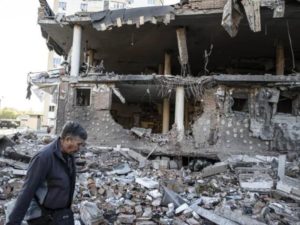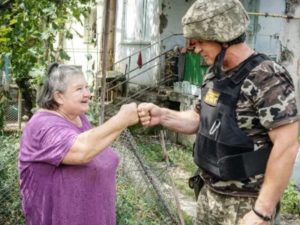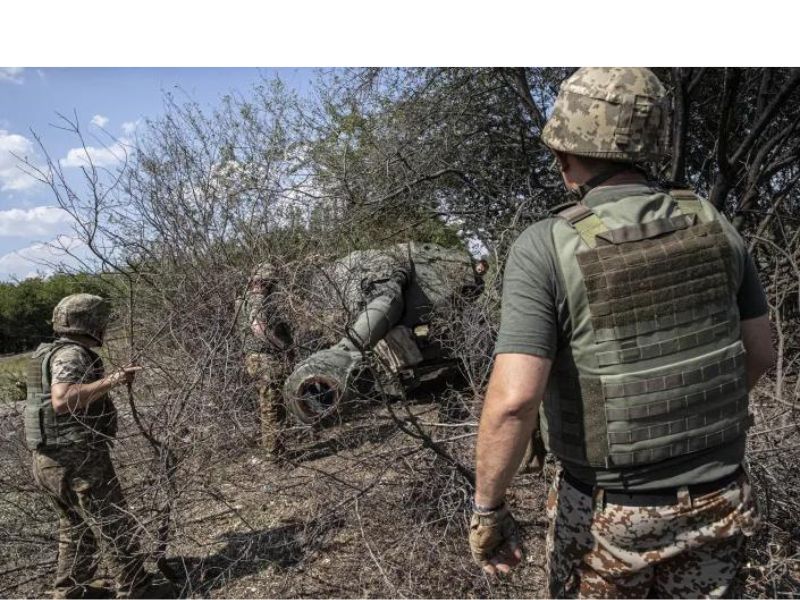KYIV, Ukraine — “Lenin” can’t sleep at night after what he saw in the morgue in Rostov. Corpses of those killed in Ukraine, he told his friend, “swim in a cauldron of formalin.” And to make positive identifications, you have to fish them out with a stick, he said. The unidentifiable require DNA tests. “In short,” Lenin said, “I’m f***ing freaking out.”

Lenin is the pseudonym of a Russian soldier whose name is unknown but whose grim experience was recounted by one of his confidants in a phone call made on Sep. 5 and intercepted by a Western intelligence agency.
Yahoo News has been unable to independently verify the identities of the speakers or what caused the described carnage. But the anecdote tracks with what Russian soldiers and their increasingly forlorn boosters have been saying for days now on social media.
Ukraine’s multipronged offensives, first around Russian-occupied Kherson and now, somewhat unexpectedly, around Kharkiv in Ukraine’s east, are unleashing significant damage on the Russian military.
Videos showing alleged Russian prisoners of war — the latest was a lieutenant colonel — have flooded Telegram channels.
Although Kyiv imposed a media blackout on Kherson at the start of its campaign last week, the government has confirmed the recapture of significant square miles of terrain.
On Sep. 7, Ukraine’s Southern Operational Command announced that it had captured several settlements, adding to two villages taken three days earlier. The blue-and-gold standard has been raised on rooftops throughout the region.

Online trackers have cited an uptick in Russian equipment losses, sharing numerous videos showing victorious Ukrainian troops with spoils of war left behind as the Russians retreated.
Tellingly, Ukraine’s fleet of Turkish Bayraktar TB-2 drones is now hitting targets of opportunity along the frontline, no longer being reserved for bigger quarries such as command-and-control centers, air defense systems, and logistics vehicles.
The Ukrainians have also been using fresh divisions equipped with NATO weaponry, most notably Polish T-72M tanks and a variety of Western armored personnel carriers. These divisions had been seen training with this equipment, newly arrived in the country, in the months prior.
The speed with which Ukrainian forces seem to be making headway has impressed Western observers.
But the real surprise is that they’ve also waged a simultaneous offensive hundreds of miles to the north in Kharkiv, near the eastern border with Russia. The city, one of the largest in Ukraine, has suffered continuous bombardment since Russia launched its invasion in February.
Igor Girkin, an officer with Russia’s Federal Security Service (FSB) and the sanctioned former commander of Russian proxy forces in the occupied province of Donetsk, posted on the Telegram social media site that Russian forces had been encircled in Balakliya, a city in the Kharkiv region.
Girkin obliquely praised the “outstanding audacity” of Ukrainian attacks for their speed and aggression. Girkin also groused about the poor training of the Russian National Guard, and the “caution” of the Russian Air Force in refraining from retaliatory strikes.
At least one detachment of Russian national guard apparently managed to get themselves trapped in the Balakliyaencirclement.
And on Wednesday, Grey Zone, a Telegram channel operated by Russia’s Wagner mercenary group, posted that Russian units were leaving Balakliya. “The city will likely be surrendered.”
Ukrainians also appear to be trapping the Russians in the south.
All modes of transport for the Russians across the Dnipro River have now been either destroyed or rendered impassable for motorised traffic.
The Antonovsky road bridge, which had been pounded by U.S.-supplied High Mobility Artillery Systems (HIMARS) for weeks, is out of commission.
The road bridge over the Nova Kakhovka dam in Kherson appears to have collapsed, judging from satellite footage. Several other smaller crossings, including both a road and a pontoon bridge over the Inhulets tributary at Darivka, have been destroyed.
The collective effect cuts the Russian-controlled zone on the west bank of the Dnipro nearly in half.
The push to reclaim Kherson and its provincial capital city, the first big population center captured by Russia at the start of the invasion in late Feb., has been telegraphed for months by Ukrainian officials.
Kherson lies at the mouth of the Dnipro and serves as a major administrative and transportation hub. For the Russians, it’s the area directly north of Crimea and therefore losing it gives Ukraine closer proximity from which to wage attacks on the peninsula occupied by the Kremlin since 2014.
Russia had made plans to stage a “referendum” to essentially annex Kherson, much as it did Crimea. Those plans have now been “paused,” according to TASS.
Moscow’s ultimate goal in the Ukraine’s south had always been the creation of a strategic land corridor, stretching eastwards from Crimea to the Russian mainland, and westwards through Odesa, reaching to the unrecognized Russian-backed separatist state of Transnistria. This would have landlocked Ukraine, decimating the economic prospects of a country that relies heavily on maritime exports.
The drumbeat about Kherson looks to have been an information operation as much as a forecast of a coming military one.
It forced Russia to transfer battalion tactical groups from other fronts to fortify its defenses, putting them in battle space where the Ukrainians felt more confident fighting. This gambit also helps put into perspective the attacks on Russia’s Saki Air Base in Crimea last month.
The destruction of over half the Black Sea Fleet’s naval air force, as per one Western intelligence official, prompted the Russians to pull their aviation farther away from Kherson, no doubt contributing to the tentative attitude alluded to by Girkin.
In a new essay about Ukraine’s strategic prospects for 2023, Gen. Valeriy Zaluzhnyi, the commander in chief of the Ukrainian Armed Forces, and Lt. Gen. Mykhailo Zabrodskyi, first deputy chairman of the National Security, Defense and Intelligence Committee of the Ukrainian Parliament, acknowledged that “a series of successful missile strikes” was used against the Saki Air Base.
This would suggest that Ukraine does indeed possess long-range, previously unpublicized munitions capable of striking deep inside enemy territory.
So far, Ukrainian casualties in the southern front don’t seem to be overwhelming, according to the Economist, which visited hospitals in Odesa and Mykolaiv, northwest of Kherson.
A doctor working in the main emergency unit interviewed by the outlet said that, on average, 15 to 30 soldiers were coming in each day. “More than usual, but not our worst nightmare.”
Source: Yahoo news









